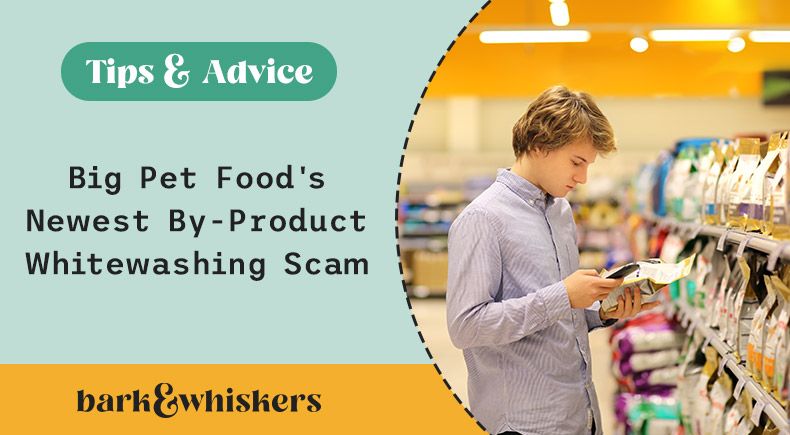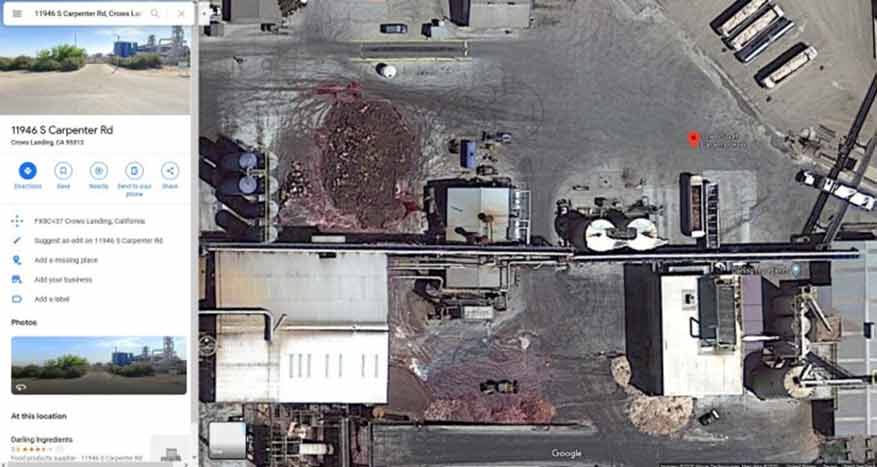Big Pet Food's Newest By-Product Whitewashing Scam
It's a fact: The ultraprocessed pet food industry uses human food waste, aka by-products, in pet food, including ingredients that failed inspection and others that aren't fit for consumption by humans or animals. Here's how industry is working to reshape your perception of these 'leftovers.'

STORY AT-A-GLANCE
- If you’re like so many other knowledgeable pet parents, you’ve grown skeptical of terms like “sustainability” and “eco-consciousness” coming from the ultraprocessed pet food industry
- Clearly, the use of these terms is an attempt to reframe big pet food’s long-standing use of human food industry waste (aka by-products) in pet food to recapture the interest of pet parents who increasingly avoid these types of ingredients
- As part of this effort, the industry is hoping to rebrand by-products as “co-products” and even “leftovers”
- Thankfully, observant pet parents will recognize that nothing about the actual ingredients is changing, rather, the focus is on changing consumer perception through wordplay and appealing marketing campaignsircling
“Recycling” and “sustainability” are words associated with the protection and preservation of the environment. However, as is so often the case with ideas born of a desire to do something positive, individuals and entities with less-than-pure motives are frequently working behind the scenes to use such concepts to their own advantage.
This occurs frequently in the ultraprocessed pet food industry with regard to the use of waste products from the human food industry, aka by-products, in pet food. Many pet food manufacturers employ the terms “upcycling” and “sourced sustainability” to not only explain, but also market and advertise the inclusion of human food industry garbage in their products.
An article in a pet food industry journal perfectly illustrates the point. In fact, the manipulative magic is in play immediately, in the title:
‘Beautiful system’ supplies by-products to make pet food1
The use of the term “beautiful system” to describe the process of turning the waste products of the human food industry into pet food is jaw-dropping.
The article explains that over a century ago, the F.L. Emmert Company, which makes pet food and livestock feed ingredients from brewer’s yeast, began arranging for the transport of beer brewing by-products (yeast) to dairy farms. According to Emmert executive vice president Elizabeth Barber, if the yeast products weren’t fed to cats, dogs and livestock, “the nutritious fungi would end up rotting in a landfill.”
The Truth About the ‘Nutritious Fungi’ in Pet Food
Many advertised “health foods” used as ingredients in pet food are by-products of the human food industry, for example, beet pulp, pecan and peanut hulls, and brewer’s yeast.
These by-products aren’t necessarily harmful for dogs and cats; however, they’re used in pet food because, as Barber alludes to above, companies can sell them vs. paying a landfill company to dispose of them. These products make fine fertilizers and are probably better suited for that purpose.
Both brewer’s yeast and nutritional yeast come from the yeast species Saccharomyces cerevisiae. One is a byproduct of the brewing industry grown on malted barley; the other is grown on synthetically enriched cane sugar or molasses. Brewer’s yeast contains tyramine, which can negatively affect some pets; it can also contain naturally occurring glutamic acid (MSG), which is an excitotoxin.
Websites discussing the consumption of brewer’s yeast contain “consult your doctor before consuming” warnings because it can interact negatively with human medications. Most brewer’s yeast has also been genetically modified and synthetically fortified.
Yeast is admittedly a confusing topic, because while some yeast can be problematic, some can be beneficial in small quantities. In addition to yeast in foods (brewers, nutritional, bakers), there are yeast-based probiotics, like S. boulardii, which can promote gut health in pets, especially those with sensitive stomachs.
Then there’s the type of yeast that grows on the body. All pets’ bodies have yeast, but some strains are opportunistic and can become problematic (e.g. Malassezia dermatitis, which causes terrible skin irritation).
Bakers and brewer’s yeast are considered “active,” which means they can grow and reproduce, requiring glucose (sugar) as a food source. These yeasts use sugar as a primary food source, so if you feed them to your pet alongside a carb-based diet, the potential for yeast overgrowth can occur. Nutritional yeast has been inactivated, so it provides a good source of B vitamins in homemade pet food recipes and does not cause or exacerbate yeast infections.
Wordplay: From By-Products to Co-Products to ‘Leftovers’
According to the journal article, “Beyond brewer’s yeast, many pet food ingredients come from otherwise wasted human food products. Economic efficiency and ecology can find common ground in co-products.”
Note the switch from “by-products” to “co-products.” The pet food industry is awake to the fact that a growing number of consumers don’t want to see by-products in the pet food they buy. Apparently, the industry hopes substituting the word “co-products” for “by-products” (with no change to the actual ingredients) will reverse this trend.
Said another way, pet food producers and their raw material suppliers are continuing to keep costs low while claiming to be eco-conscious, and the “common ground” they’ve found to accomplish this is repurposing human food industry waste as pet food.
“It's a beautiful system,” according to Barber. “Something has to happen to these leftovers, and we know it's good for the livestock. We take it from one place and get it to the place that needs to be. That same thing is happening in all of the pet food industry.”
Leftovers? The term “leftovers” implies the food was fine for consumption by humans, but there was too much of it, so it was shared with animals. I encourage pet parents to share species-appropriate leftovers (fruits, veggies, and meats) with their pets. USDA-approved meat trim and organs fit this definition and are excellent sources of food for pets. So is less-than-perfect produce.
Many humans won’t eat a bruised organic apple, but their pets certainly will. The quality is still excellent.
However, USDA-inspected and FAILED ingredients should never be referred to as “leftovers.” These ingredients can contain mycotoxins, excessive lead, and/or other contaminants that aren't safe for consumption, but they’re also included in the category of by-products used in pet food. USDA-approved, safe-for-human-consumption food leftovers should be used in pet food; waste products/inspection-failed ingredients should not.
If they’re included, they should be explicitly labeled so consumers know what they’re buying. However, they aren’t — they’re deemed “feed grade,” so no labeling is required. Again, the best place for unsafe-for-consumption human food industry by-products is compost piles, so they can be recycled for use as fertilizers.
Consumers Don’t See the ‘Value’ of By-products
According to another pet food industry article on the same subject, “for years, there’s been a disconnect between the pet food industry and consumers about the value of by-products,” and this so-called disconnect is “wasting the potential of human food stream leftovers.”2
By-product usage serves as a “huge sustainability story for the pet food industry,” according to Barber:
“People in the industry take for granted that others know the same,” she says. “That may be where this disconnects starts. Consumers have heard a different story about by-products from marketers, bloggers and others. The by-product, co-product and rendering industries, along with pet food brands, must tell this sustainability story. Otherwise, people will believe what they read wherever.”
Another warrior on the front lines fighting for safe, nutritious pet food, Susan Thixton of TruthAboutPetFood.com, vehemently disagrees and argues that “You Can’t Put Perfume on Condemned, Diseased, Decomposing By-products.”
“Most pet owners have no issue with healthy internal organs being processed into pet food as a by-product left over from USDA inspected and passed animals slaughtered for human consumption,” Susan writes.
What we do have a problem with is condemned internal organs that are processed into pet food as a by-product (a violation of federal law) with NO disclosure on the pet food label.
We have a problem with illegal, nonslaughtered, decomposing, dead livestock processed into pet food as a by-product with a picture of a grilled steak on the pet food label. We have a problem with the huge lack of transparency in quality of ingredients.
We have a problem with a pet food/animal feed ingredient supplier claiming they make ‘Nutritional, functional, sustainable ingredients for animals’ and see that the ‘nutritional ingredients’ they produce are sourced from this:

We have a problem with the above ‘nutritional’ raw material dumped on pavement, in the sun, in July — building up massive loads of bacteria that when cooked produce massive loads of endotoxins poisoning pets.
We have a problem with FDA and every other pet food regulatory authority ignoring laws allowing industry to dump illegal waste (such as diseased animals and animals that have died other than by slaughter) in pet foods with no warning or disclosure on the label.”3
I’m in complete agreement with Susan, and certainly no amount of renaming garbage ingredients in pet food, claims of sustainability and utter nonsense like the following will convince us otherwise.
“Owners need confidence that pet food is safe. They like the idea of recycling and sustainability, but they don’t want to feel like they’re feeding their pets recycled ingredients they wouldn’t eat themselves. That presents a unique challenge to pet food manufacturers that do their best to minimize food waste by using leftovers from human food production.
Initially people considered ‘leftovers’ from food production to be by-products. Now we recognize these more appropriately named co-products as an essential part of the pet food industry.”4
Have You Had Enough of the Ultraprocessed Pet Food Industry?
Thanks to mislabeled products, deceptive marketing techniques, low-grade ingredients, too-frequent recalls, and an exploding population of pets with chronic digestive issues, allergies and degenerative disease, it's no wonder so many pet parents are exploring homemade diets, fresh food diets made by smaller, transparent pet food producers, raw diets (some of which are pasteurized) and other alternatives to the dead, rendered, dubious, ultraprocessed feed-grade "fast food".
My advice? Search this website for more information on choosing the best diet for your pet. There are dozens of videos and articles here that can help you become more knowledgeable about pet nutrition so that you can make the best diet choices for your own dog or cat. You can also learn what real transparency in pet diets looks like by ordering the Truth About Pet Food 2023 List.
If you want to help change the deceptive practices occurring in the pet food industry, I recommend becoming a member of the Association for Truth in Pet Food, which is the only organization out there committed to holding the regulatory agencies and AAFCO accountable. You can also check this list for the pet food companies that have taken the ingredient transparency pledge.
Sources and References
Today's Pet Video:
Rescued Kitten Becomes One of the Kids
These little girls’ dad said they could foster the kitten until they find her a family, but their mom notes with a wide, knowing smile: That’s probably not how it’s going to happen!











